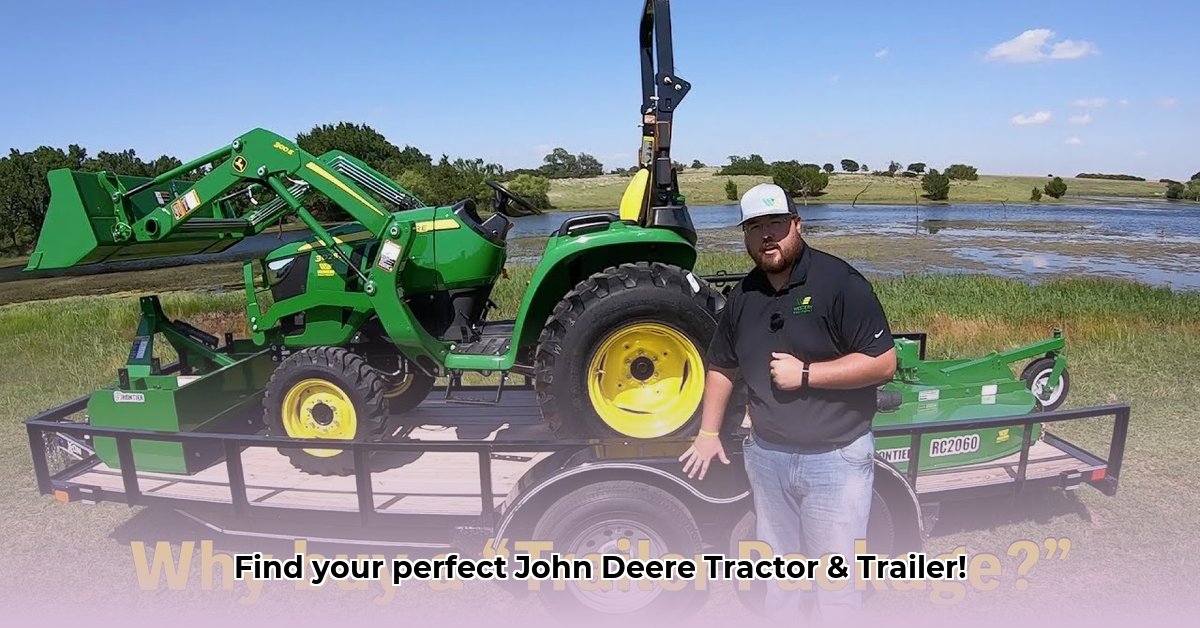
Choosing the right John Deere compact utility tractor and trailer package is a crucial decision for any farmer. This comprehensive guide will help you navigate the options to find the perfect fit for your needs and budget in 2025. We'll cover model comparisons, financing options, and sustainability considerations, equipping you to make an informed purchase. For more information on compatible trailers, check out this helpful resource: John Deere Trailers.
Understanding John Deere's Compact Utility Tractor Packages
John Deere offers a diverse range of compact utility tractors, each suited to different needs and budgets. Models like the 1025R, 2025R, and 3038E offer varying horsepower, transmission types (hydrostatic for maneuverability or synchro for open fields), and implement capabilities. Selecting the right tractor is crucial – much like choosing the right tool for a specific job.
Matching Your Tractor to Your Tasks
Before browsing, assess your tasks. Will you primarily haul supplies, move equipment, or perform other operations? Your workload directly impacts your horsepower needs. Smaller farms may find the 2025R sufficient, while larger operations might require the extra power of a 3038E or a larger model. Terrain is another critical factor; hydrostatic transmissions excel in tighter spaces, while synchro transmissions are ideal for open fields.
Let's Talk Numbers: Pricing and Financing
John Deere tractor prices range significantly ($18,700 to over $37,900 for new tractors), influenced by model, features, and dealer location. Financing options through John Deere Financial can make ownership more attainable, with potential monthly payments ranging from $279 to $529+ depending on the model, down payment, and loan term. Always confirm pricing and financing terms directly with your local dealer.
| Model | Horsepower | Transmission Type | Typical Implement Package | Approximate Price Range (USD) |
|---|---|---|---|---|
| 1025R | 23.9 | Hydrostatic | Loader, mower | $18,700 - $25,000 |
| 2025R | 24.5 | Hydrostatic | Loader, mower, box blade | $22,000 - $30,000 |
| 3038E | 37.3 | Synchro | Loader, backhoe, various attachments | $35,000 - $40,000+ |
Important Note: These prices are estimates and may vary based on dealer, additional features, and market conditions.
Picking the Right Trailer: A Crucial Choice
Trailer selection is as critical as tractor choice. Ensure the trailer's weight capacity aligns with your tractor's towing capacity to prevent overloading and potential accidents. Consider typical load sizes and weights for safe and efficient operation. Proper weight distribution is crucial for stability.
The Green Side: Sustainability with John Deere
John Deere's compact utility tractors promote sustainable farming. Their smaller size often means lower fuel consumption and a reduced carbon footprint compared to larger tractors. Their maneuverability also minimizes soil compaction, improving efficiency and long-term land health. "Investing in fuel-efficient equipment is a key step towards sustainable farming practices," says Dr. Emily Carter, Professor of Chemical and Biomolecular Engineering at Princeton University.
Your Step-by-Step Guide to Tractor Ownership
This structured process simplifies your tractor purchase:
- Assess Your Needs: Detail your primary uses, property size, and typical loads.
- Select Your Tractor: Choose the appropriate model based on your needs and budget.
- Choose Your Implements: Select necessary attachments, including the trailer.
- Explore Financing Options: Research financing options available through John Deere Financial or other lenders.
- Verify Your Eligibility: Check for any geographic restrictions or requirements.
- Visit Your Local Dealer: Discuss your options, potentially test drive models, and finalize your purchase.
How to Choose the Best John Deere Compact Tractor for Sustainable Farming
Selecting a tractor for sustainable farming requires a thoughtful approach, focusing on the following:
Matching Tractor Size to Your Farm
Tractor size directly correlates to land size. John Deere's 1-4 Series compact tractors suit smaller operations (generally under 10 acres), while the 5 and 6 Series utility tractors offer greater capabilities for larger farms. Avoid overbuying; a tractor that's too large is wasteful and cost-inefficient.
Powering Your Sustainable Practices
Horsepower directly impacts your operational capabilities. Lighter tasks demand less power, while heavier tasks like plowing require significantly more. Consider future needs; if your operation is likely to expand, investing in a more powerful model might be beneficial.
Sustainability: More Than Just Green Paint
Sustainable farming extends beyond the tractor's aesthetics. Fuel efficiency directly impacts running costs and carbon footprint. Durability ensures longevity, minimizing waste and resource consumption. "Choosing durable equipment reduces the environmental impact associated with frequent replacements," notes Michael Davis, Agricultural Engineer at the University of California, Davis.
The Cost-Benefit Equation
Carefully weigh the costs and benefits of different models. Larger tractors provide more productivity but incur higher initial costs. Smaller tractors require more time but demand a lower upfront investment. A comprehensive cost-benefit analysis, incorporating fuel consumption, maintenance, and lifespan, is critical.
Remember to consult your local John Deere dealer for expert advice and up-to-date pricing and availability. Happy farming!